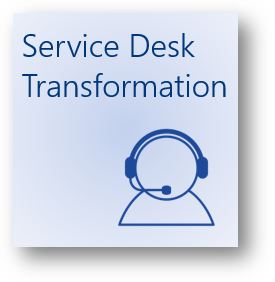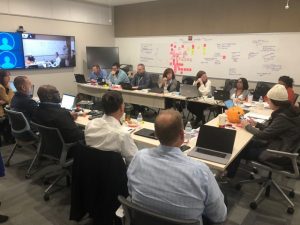 Over the last 10 weeks, the IS Service Desk has been working through the initial phase of major transformation focused on improving the IS customer experience delivery model. Service Desk is one of the primary drivers of the customer experience with IS and:
Over the last 10 weeks, the IS Service Desk has been working through the initial phase of major transformation focused on improving the IS customer experience delivery model. Service Desk is one of the primary drivers of the customer experience with IS and:
- Answers more than 50,000 calls per month
- Closes in excess of 60% the total incidents generated
- Touches nearly 90% of all tickets across IS
Previously we’ve shared the four core strategies driving the Service Desk transformation and are now celebrating a few wins this team has been able to accomplish with support from across the department.
Move to one number
On November 8, the Renton, Beaverton, and Lubbock Service Desk locations were all aligned on a single call management platform. Most users experienced this change by the move to the single number (844) 92-askIT, however, this change was far more foundational than just a phone number. This change marked the first time ever that we could triage calls across all of PSJH. Additionally, this change allows for a single quality assurance program to be implemented across all locations, a common dashboard and set of operational metrics to be used, and supports the use of future functionality in Service Now. Lastly, the move to a common platform reduces our need to maintain minimum staffing at multiple locations when call volumes are low and allows us to move those caregivers to high-volume daytime hours, thus decreasing caregiver hold time without driving up expense.
Formation of Service Desk executive steering committee
In October, an executive steering committee was formed with the purpose of looking at IS service delivery, then identifying how we can improve the customer experience, address up-stream volume drivers, and target resiliency into our systems. This committee includes B.J. Moore, Rick Stover, Doug Lewis, Dr. Michael Marino, and Tabitha Lieberman, and has already met twice to begin using our operational data to drive change in this space. Jelena Ramsey, who joined the team on Nov. 25 as the director of IS customer experience enhancement, is working with this executive group to generate a “Service Scorecard” that will be shared with all senior core leaders, so they can understand how their areas of accountability impact the IS customer experience.

Maturity assessment
On Dec. 10, key core leaders and caregivers from across the enterprise came together to develop a roadmap for how we mature our ServiceNow platform in the customer service arena. This work is foundational to many of the new technologies we are looking to implement, and will enable products like support chat, self-service, artificial intelligence (AI), and other automation. This roadmap will drive much of the ServiceNow optimization work that will occur in the future. It’s important to note that, even though we are building future-facing roadmaps to mature the platform, we are still actively working to optimize the ServiceNow platform as it exists today. We have two optimizations going live in December – one will automate an existing manual work flow tied to printer service; the other will empower better data related to how customers perceive their service delivery experience.
Partnering with EUS to holistically transform the service delivery model
Over the last 10 weeks leadership from the Service Desk and End User Support have been partnering to look at the end-to-end service experience and define how we can simplify and improve the process. This work has identified several near-term and future bodies of work that will drive process and service efficiency across these two teams that most often are part of the customer experience.
As we look to the future, there are some really exciting bodies of work starting to unfold. We’re looking forward to sharing more as the planning around these initiatives unfolds, but as a preview, here are some of the things we are working on:
Redefining the service model: As we think about how we deliver service in the future, our goal will be to avoid problems before they occur by architecting availability into our systems. Our focus on service data and analytics will help empower understanding of where we need to focus our efforts. When problems do occur that require support, we will strive to empower self-service solutions, and if a call to the help desk is required, we will focus on redefining the service model so more problems can be solved via a single phone call rather than downstream support solutions.
Maturing knowledge & operational processes: Our enterprise knowledge base (KB) is foundational to many of the customer-centered technologies we are looking to implement. Self-service tools and online support chat use the knowledge base to support automation and ticket routing. We have a great deal of work to do to mature our knowledge base, this will be a key focus across all IS teams. Additionally, we have substantial work to do to mature our operational processes for how we manage and handle tickets. Today, we have more than 12,000 tickets that are overdue, 11,000 that are unassigned, and more than 15,000 that haven’t been updated in over seven days. We as an IS team need to mature this area to drive these numbers down.
Convenience tools: We are partnering with the telecom team to look at options to provide more convenient solutions to caregivers calling the Service Desk. These include looking at call-backs rather than having caregivers wait on hold, scheduling call-backs during lower call volume times, and providing more information to caregivers on typical wait times, so they can schedule when they call the help desk (when applicable, as clearly some issues can’t be scheduled).
Innovating and developing new support tools: As we modernize our service model, we will also look to modernize tools supporting it. We are already looking at various tools to develop a capability for caregivers to interact with the Service Desk via a chat bot. Additionally, we are talking with a couple firms that develop AI to further enable these tools.
“I’m excited to have seen our team deliver some of these quick wins for improving the customer experience, but want to remind us that we are all accountable for the IS service experience,” shares Chris Briggs, GVP of IS strategic technology enablement.
More information
Should you have any questions about this work, or would like to have someone come to your team and talk about this work, please reach out to Chris Briggs or Ronnie Rush, service desk director
